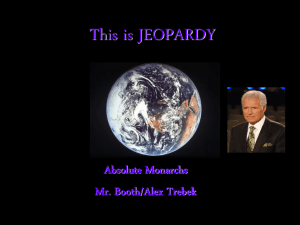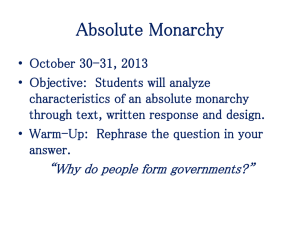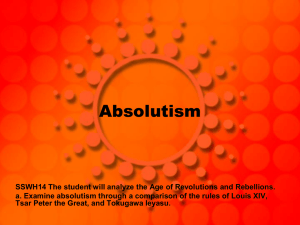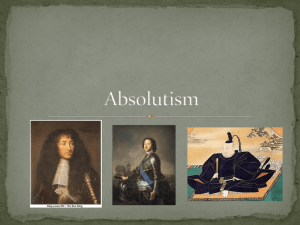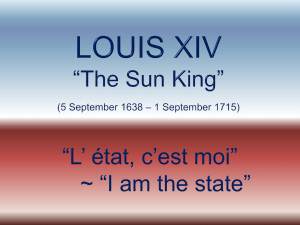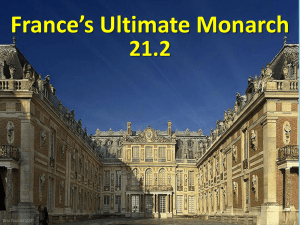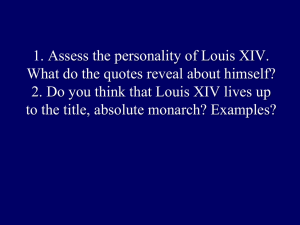france divine
advertisement
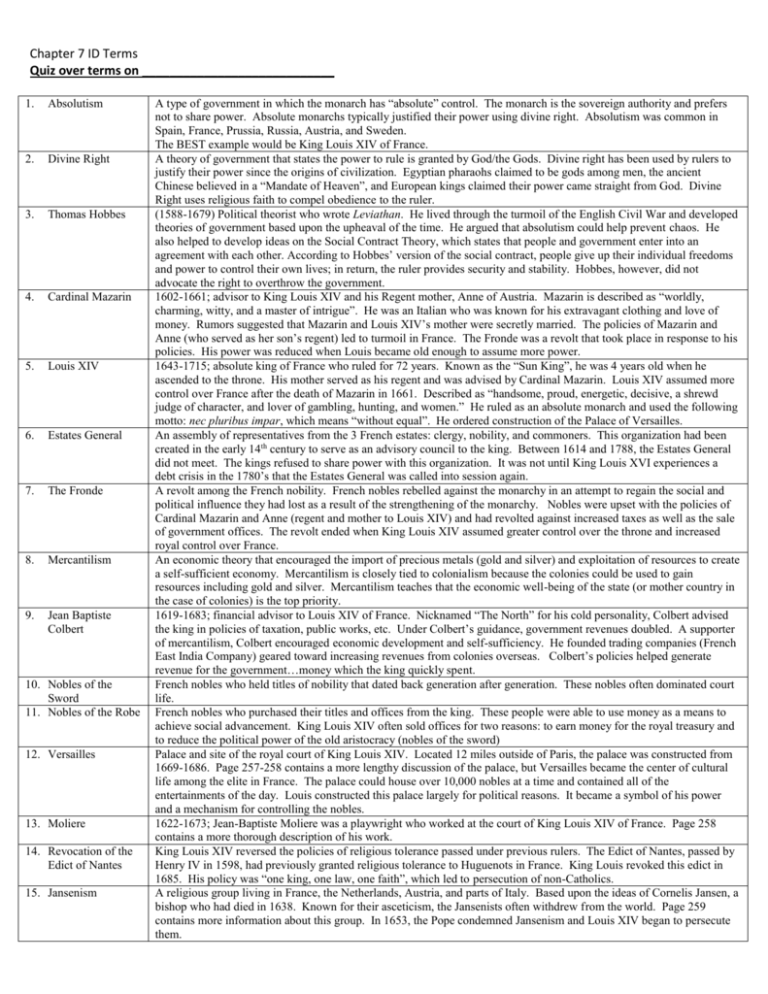
Chapter 7 ID Terms Quiz over terms on ____________________________ 1. Absolutism 2. Divine Right 3. Thomas Hobbes 4. Cardinal Mazarin 5. Louis XIV 6. Estates General 7. The Fronde 8. Mercantilism 9. Jean Baptiste Colbert 10. Nobles of the Sword 11. Nobles of the Robe 12. Versailles 13. Moliere 14. Revocation of the Edict of Nantes 15. Jansenism A type of government in which the monarch has “absolute” control. The monarch is the sovereign authority and prefers not to share power. Absolute monarchs typically justified their power using divine right. Absolutism was common in Spain, France, Prussia, Russia, Austria, and Sweden. The BEST example would be King Louis XIV of France. A theory of government that states the power to rule is granted by God/the Gods. Divine right has been used by rulers to justify their power since the origins of civilization. Egyptian pharaohs claimed to be gods among men, the ancient Chinese believed in a “Mandate of Heaven”, and European kings claimed their power came straight from God. Divine Right uses religious faith to compel obedience to the ruler. (1588-1679) Political theorist who wrote Leviathan. He lived through the turmoil of the English Civil War and developed theories of government based upon the upheaval of the time. He argued that absolutism could help prevent chaos. He also helped to develop ideas on the Social Contract Theory, which states that people and government enter into an agreement with each other. According to Hobbes’ version of the social contract, people give up their individual freedoms and power to control their own lives; in return, the ruler provides security and stability. Hobbes, however, did not advocate the right to overthrow the government. 1602-1661; advisor to King Louis XIV and his Regent mother, Anne of Austria. Mazarin is described as “worldly, charming, witty, and a master of intrigue”. He was an Italian who was known for his extravagant clothing and love of money. Rumors suggested that Mazarin and Louis XIV’s mother were secretly married. The policies of Mazarin and Anne (who served as her son’s regent) led to turmoil in France. The Fronde was a revolt that took place in response to his policies. His power was reduced when Louis became old enough to assume more power. 1643-1715; absolute king of France who ruled for 72 years. Known as the “Sun King”, he was 4 years old when he ascended to the throne. His mother served as his regent and was advised by Cardinal Mazarin. Louis XIV assumed more control over France after the death of Mazarin in 1661. Described as “handsome, proud, energetic, decisive, a shrewd judge of character, and lover of gambling, hunting, and women.” He ruled as an absolute monarch and used the following motto: nec pluribus impar, which means “without equal”. He ordered construction of the Palace of Versailles. An assembly of representatives from the 3 French estates: clergy, nobility, and commoners. This organization had been created in the early 14th century to serve as an advisory council to the king. Between 1614 and 1788, the Estates General did not meet. The kings refused to share power with this organization. It was not until King Louis XVI experiences a debt crisis in the 1780’s that the Estates General was called into session again. A revolt among the French nobility. French nobles rebelled against the monarchy in an attempt to regain the social and political influence they had lost as a result of the strengthening of the monarchy. Nobles were upset with the policies of Cardinal Mazarin and Anne (regent and mother to Louis XIV) and had revolted against increased taxes as well as the sale of government offices. The revolt ended when King Louis XIV assumed greater control over the throne and increased royal control over France. An economic theory that encouraged the import of precious metals (gold and silver) and exploitation of resources to create a self-sufficient economy. Mercantilism is closely tied to colonialism because the colonies could be used to gain resources including gold and silver. Mercantilism teaches that the economic well-being of the state (or mother country in the case of colonies) is the top priority. 1619-1683; financial advisor to Louis XIV of France. Nicknamed “The North” for his cold personality, Colbert advised the king in policies of taxation, public works, etc. Under Colbert’s guidance, government revenues doubled. A supporter of mercantilism, Colbert encouraged economic development and self-sufficiency. He founded trading companies (French East India Company) geared toward increasing revenues from colonies overseas. Colbert’s policies helped generate revenue for the government…money which the king quickly spent. French nobles who held titles of nobility that dated back generation after generation. These nobles often dominated court life. French nobles who purchased their titles and offices from the king. These people were able to use money as a means to achieve social advancement. King Louis XIV often sold offices for two reasons: to earn money for the royal treasury and to reduce the political power of the old aristocracy (nobles of the sword) Palace and site of the royal court of King Louis XIV. Located 12 miles outside of Paris, the palace was constructed from 1669-1686. Page 257-258 contains a more lengthy discussion of the palace, but Versailles became the center of cultural life among the elite in France. The palace could house over 10,000 nobles at a time and contained all of the entertainments of the day. Louis constructed this palace largely for political reasons. It became a symbol of his power and a mechanism for controlling the nobles. 1622-1673; Jean-Baptiste Moliere was a playwright who worked at the court of King Louis XIV of France. Page 258 contains a more thorough description of his work. King Louis XIV reversed the policies of religious tolerance passed under previous rulers. The Edict of Nantes, passed by Henry IV in 1598, had previously granted religious tolerance to Huguenots in France. King Louis revoked this edict in 1685. His policy was “one king, one law, one faith”, which led to persecution of non-Catholics. A religious group living in France, the Netherlands, Austria, and parts of Italy. Based upon the ideas of Cornelis Jansen, a bishop who had died in 1638. Known for their asceticism, the Jansenists often withdrew from the world. Page 259 contains more information about this group. In 1653, the Pope condemned Jansenism and Louis XIV began to persecute them. Chapter 7 ID Terms Quiz over terms on ____________________________ 16. War of the Holy League 17. Junker 18. Great Elector Frederick William 19. Ivan the Terrible 20. Boyar 21. Time of Troubles 22. Serfdom 23. Peter the Great 24. Table of Ranks 25. St. Petersburg 26. Balance of Power 27. War of Spanish Succession 28. Treaty of Utrecht 29. Bishop Bossuet 30. Treaty of Nystad Conflict between Austria and the Ottoman Empire (1686-1687). The Ottomans (a Muslim empire) had been attacking eastern and central Europe; they had claimed Hungary and even laid seige to Vienna, the capital of Austria. The Austrian Hapsburgs put together an army to fight back the Ottoman advances. The Hapsburg army was able to reclaim most of the lands of Hungary and Transylvania from the Ottomans. Prussian nobles and land-owners Ruler of Prussia from 1640-1688. Built Prussia’s military to create a very militaristic society. He created a centralized government and helped to strengthen Prussia. Ivan IV ruled Russia from 1533-1584. He was the first ruler of Russia to be crowned tsar (also spelled czar). Raised in a world of violence, Ivan did not shy away from using violence to solidify his own political power. He was both a devout man but was known for being prone to violent rages. In a fit of rage, he killed his oldest son and heir. Upon his death in 1584, Russia was hurled into the “Time of Troubles” Russian noble 1598-1613, a period of anarchy and chaos in Russia. Weak rulers allowed the boyars to assume more power; the nobles then fought among themselves for power. The “Time of Troubles” ended with the election of the first Romanov tsar. The Romanov family would rule Russia until the last czar (Nicholas II) was killed during the Bolshevik Revolution in the early 1900’s. In 1649, Russian peasants were officially labeled serfs. Russian serfdom was an extreme form of serfdom which bordered on slavery. While peasants in other parts of Europe were gaining more freedom and economic opportunity, Russian peasants lived a life of misery. Serfdom would not be abolished in Russia until 1861. Ruler of Russia from 1682-1725. As a boy, Peter was wildly fascinated by the military. His interest in weaponry and military strategy served him well as a ruler. He was responsible for modernizing Russia’s military and creating its first navy. Described as being nearly 7 ft tall and possessing a frantic energy, Peter often dressed in shabby, old clothes and wore his hair long. Peter was rough around the edges and often carried out executions himself with the use of an axe. At the age of 25, he traveled to Western Europe to learn about the more “advanced” countries. He traveled in disguise and often spent time with common people. The “cultured” members of Western European society saw him as savage and lacking in manners. While traveling, Peter became fascinated by math, ship building, western education, western dress, etc. Upon his return to Russia, he ordered the nobles to begin to dress and act like their western counterparts. He passed laws requiring nobles to shave their beards and wear western-style clothing. Peter also helped to expand Russian territory by reorganizing the military. He went to war with Sweden to gain access to a warm-water port. He built his new capital, St. Petersburg, on the Gulf of Finland, an inlet of the Baltic Sea. 1722, policy created by Czar Peter the Great of Russia. Male nobles (boyars) were required to serve the state either in the army, navy, or in government offices. Commoners who served in the military or government were often rewarded with titles of nobility Peter the Great’s “Window on the west”…his new capital city built on the Baltic Sea. Peter ordered the construction of this city and modeled the architecture after the styles of western Europe, particularly Amsterdam. A political idea suggesting that peace in Europe is directly tied to a balance of power. It was believed that great powers should be in equilibrium with none being too powerful or too weak. The upset of this “balance of power” will be instrumental in the course of the Napoleonic Wars and the World Wars. Military conflict from 1701-1714 over succession to the Spanish throne after the death of Charles II in 1700. Charles II (the last of the Spanish Hapsburgs) died without an heir, making it unclear who would become the new king. Charles’ will asked that Philip of Anjou (grandson of Louis XIV of France) be his successor providing that Philip refuse his inheritance of the French throne. Philip ascended to the throne of Spain in 1700, but the Austrian Hapsburgs refused to accept this. They believed someone from their family line should inherit. The Austrians were also nervous because Philip was still in line to inherit the French throne, which would result in a possible union between France and Spain. Other countries were also alarmed by the possibility of Spain and France becoming one kingdom, which led to war. The war ended with the Treaty of Utrecht. Signed in 1713 to end the War of Spanish Succession. The question of the Spanish Succession was finally settled in favor of the Bourbon Philip V, grandson of France’s Louis XIV. Britain received the largest portion of colonial and commercial spoils and took the leading position in world trade 1627-1704; he served as Bishop and tutor to Louis XIV. Bishop Jacques Bossuet was a supporter of Divine Right. 1721; Treaty which ended the Great Northern War, a military conflict between Russia and Sweden. Russia wins and gains access and eventually became the dominant power in the Baltic. Russia also gained control over Estonia and parts of modern-day Finland.
